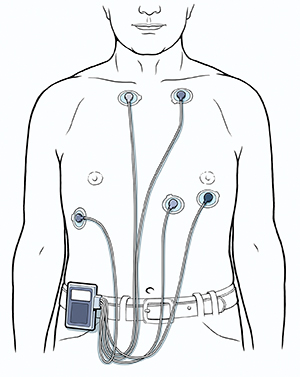Your health care provider has ordered a Holter monitor to check if you have an arrhythmia. An arrhythmia is a change from the normal speed (normally 60 to 100 beats per minute) or pattern (rhythm) of your heartbeat. This is due to changes in the way the electrical signal moves through the heart to make it contract. It can cause the heart to beat too fast (tachycardia) or too slow (bradycardia). Or it can cause the heart to beat in an uneven pattern (irregular rhythm). Any arrhythmia that takes place during the test period will be recorded for your health care provider or care team to see. Knowing the type of arrhythmia can help your provider find its cause and advise a treatment.
Unlike an electrocardiogram (ECG) or a monitor used in the emergency room, a Holter monitor is a small, portable device. It's used to track your heart rhythm for at least 24 to 48 hours while you do your normal activities. This raises the chance that an arrhythmia will be seen, if one exists.
Some older Holter monitors (see picture below) use multiple electrodes attached to the chest and connected to a recording box. More modern Holter monitors use wireless patches. When longer-term heart monitoring is needed, other types of devices can be used instead of a Holter monitor.
Home care
Do your normal activities while wearing the Holter monitor, except:
-
Don't bathe or shower, depending on the type of Holter monitor you're wearing.
-
Don't go swimming.
-
Stay away from metal detectors. Also stay away from areas of high electrical conductivity.
Keep a diary of your activities and anything you feel while wearing the monitor. It's especially important to write down symptoms like:
-
Chest pain
-
Palpitations
-
Trouble breathing
-
Dizziness
Make sure to record the time that you felt these symptoms.
Call as directed by your health care provider to make an appointment to get your Holter monitor. The staff will explain how to use it. You'll be told how to connect the monitor and take care of it. You'll also be given instructions on how to return the monitor so the results can be reviewed.
Ask your provider when and how you'll get the test results. Ask what follow-up plans you should make based on the results.


